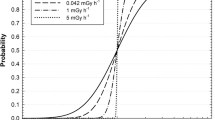Abstract
This paper suggests a methodology to estimate morbidity parameters in a three-state model, which includes the heterogeneity factor modeled by a gamma-distributed random variable. The cases of complete and incomplete information are considered and various risk estimation methods are discussed. We give estimates of morbidity radiation risks in four classes of diseases based on data from the Russian National Radiation Epidemiological Registry. The methodology can be used during the development of radiation protection systems.
Similar content being viewed by others
References
Gradshtein, I.S. and Ryzhik, I.M., Tablitsy integralov, summ, ryadov i proizvedenii (Tables of Integrals, Sums, Series, and Products), Moscow: Fizmatlit, 1963.
Ivanov, V.K., Tsyb, A.F., Gorsky, A.I, et al., Cancer Morbidity and Mortality among Chernobyl Emergency Workers: Estimation of Radiation Risks, Radiats. Biol. Radioekol., 2006, vol. 46, no. 2, pp. 159–166.
International Statistical Classification of Diseases and Related Health Problems, Geneva: IHO, 1995.
Miller, B.M. and Pankov, A.R., Teoriya sluchainykh protsessov (Theory of Random Processes), Moscow: Fizmatlit, 2002.
Mikhalskii, A.I., Metody analiza geterogennykh struktur i populyatsii (Analysis Methods for Heterogeneous Structures and Populations), Moscow: Inst. Probl. Upravlen., 2002.
Mikhalskii, A.I. et al., Accounting of Heterogeneity in the Estimation of Radiation Risks, Autom. Remote Control, 2008, vol. 69, no. 6, pp. 1045–1050.
Mikhalskii, A.I., Petrovskii, A.M., and Yashin, A.I., Teoriya otsenivaniya neodnorodnykh populyatsii (Theory of Estimation of Heterogeneous Populations), Moscow: Nauka, 1989.
Annals of the ICRP. ICRP Publication 103. The 2007 Recommendations of the International Commission on Radiological Protection, 2007, vol. 37, nos. 2–4. Translated under the title Publikatsiya 103 Mezhdunarodnoi komissii po radiatsionnoi zashchite, Moscow: Alana, 2009.
Brauer, F., Epidemic Models with Heterogeneous Mixing and Treatment, Bull. Mathem. Biol., 2008, vol. 70, pp. 1869–1885.
Statistical Methods in Cancer Research, vol. 2: The Design and Analysis of Cohort Studies, Breslow, N.E. and Day, N.E., Eds., Lyon: IARC, 1987.
Cook, R.J. and Lawless, J.F., Statistical Issues in Modeling Chrohic Disease in Cohort Studies, Stat. Biosci., 2014, no. 6, pp. 127–221.
Finkelstein, M. and Cha, J.H., Stochastic Modeling for Reliability, Springer Series in Reliability Engineering, London: Springer-Verlag, 2013.
Ivanov, V.K., Maksioutov, M.A., Chekin, S.Y., et al., The Risk of Radiation-Induced Cerebrovascular Disease in Chernobyl Emergency Workers, Health Phys., 2006, vol. 90, no. 3, pp. 199–207.
Ivanov, V.K., Tsyb, A.F., Ivanov, S.I., et al., Medical Radiological Consequences of the Chernobyl Catastrophe in Russia: Estimation of Radiation Risks, St. Petersburg: Nauka, 2004.
Madan, D., Bakshi, G., and Panayotov, G., Heterogeneity in Beliefs and Volatility Tail Behavior, J. Finan. Quantit. Anal., 2015, vol. 50, no. 6, pp. 1389–1414.
Meira-Machado, L., de Una-Alvarez, J., and Datta, S., Nonparametric Estimation of Conditional Transition Probabilities in a Non-Markov Illness-Death Model, Comput. Stat., 2015, vol. 30, no. 2, pp. 377–397.
Norberg, R., Life Insurance Mathematics. Encyclopedia of Actuarial Science, New York: Wiley, 2004.
Vaupel, J.W., Manton, K.G., and Stallard, E., The Impact of Heterogeneity in Individual Frailty on the Dynamics of Mortality, Demography, 1979, vol. 16, pp. 439–454.
Vaupel, J.W. and Yashin, A.I., Heterogeneity’s Ruses: Some Surprising Effects of Selection on Population Dynamics, Am. Stat., 1985, vol. 39, pp. 176–182.
Yashin, A.I., Akushevich, I., Arbeev, K., et al. Studying Health Histories of Cancer: A New Model Connecting Cancer Incidence and Survival, Math. Biosci., 2009, vol. 218, no. 2, pp. 88–97.
Author information
Authors and Affiliations
Corresponding author
Additional information
Original Russian Text © R.V. Ivanov, A.I. Mikhalskii, V.K. Ivanov, S.Yu. Chekin, M.A. Maksyutov, V.V. Kashcheev, 2015, published in Upravlenie Bol’shimi Sistemami, 2015, No. 57, pp. 138–157.
Rights and permissions
About this article
Cite this article
Ivanov, R.V., Mikhalskii, A.I., Ivanov, V.K. et al. On identification of morbidity parameters in a heterogeneous model: The cases of complete and incomplete information. Autom Remote Control 78, 1329–1340 (2017). https://doi.org/10.1134/S0005117917070141
Received:
Published:
Issue Date:
DOI: https://doi.org/10.1134/S0005117917070141



